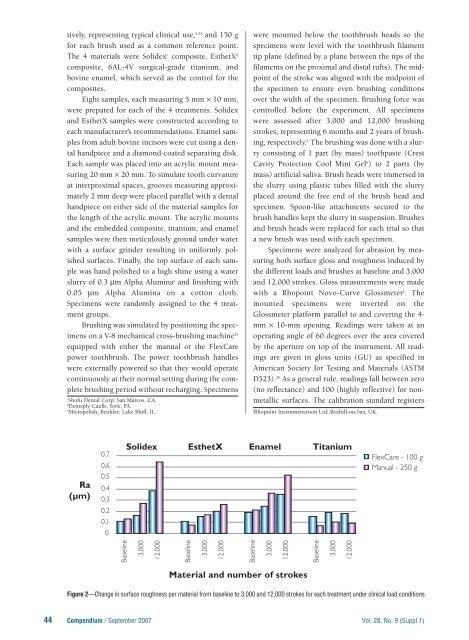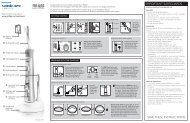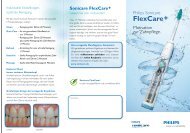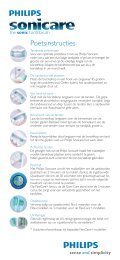Philips Sonicare FlexCare - Sonicare.com - Sonicare
Philips Sonicare FlexCare - Sonicare.com - Sonicare
Philips Sonicare FlexCare - Sonicare.com - Sonicare
Create successful ePaper yourself
Turn your PDF publications into a flip-book with our unique Google optimized e-Paper software.
tively, representing typical clinical use, 4,24 and 150 g<br />
for each brush used as a <strong>com</strong>mon reference point.<br />
The 4 materials were Solidex c <strong>com</strong>posite, EsthetX d<br />
<strong>com</strong>posite, 6AL-4V surgical-grade titanium, and<br />
bovine enamel, which served as the control for the<br />
<strong>com</strong>posites.<br />
Eight samples, each measuring 5 mm × 10 mm,<br />
were prepared for each of the 4 treatments. Solidex<br />
and EsthetX samples were constructed according to<br />
each manufacturer’s re<strong>com</strong>mendations. Enamel samples<br />
from adult bovine incisors were cut using a dental<br />
handpiece and a diamond-coated separating disk.<br />
Each sample was placed into an acrylic mount measuring<br />
20 mm × 20 mm. To simulate tooth curvature<br />
at interproximal spaces, grooves measuring approximately<br />
2 mm deep were placed parallel with a dental<br />
handpiece on either side of the material samples for<br />
the length of the acrylic mount. The acrylic mounts<br />
and the embedded <strong>com</strong>posite, titanium, and enamel<br />
samples were then meticulously ground under water<br />
with a surface grinder resulting in uniformly polished<br />
surfaces. Finally, the top surface of each sample<br />
was hand polished to a high shine using a water<br />
slurry of 0.3 µm Alpha Alumina e and finishing with<br />
0.05 µm Alpha Alumina on a cotton cloth.<br />
Specimens were randomly assigned to the 4 treatment<br />
groups.<br />
Brushing was simulated by positioning the specimens<br />
on a V-8 mechanical cross-brushing machine 25<br />
equipped with either the manual or the <strong>FlexCare</strong><br />
power toothbrush. The power toothbrush handles<br />
were externally powered so that they would operate<br />
continuously at their normal setting during the <strong>com</strong>plete<br />
brushing period without recharging. Specimens<br />
c<br />
Shofu Dental Corp; San Marcos, CA.<br />
d<br />
Dentsply Caulk; York, PA.<br />
e<br />
Micropolish, Beuhler; Lake Bluff, IL.<br />
were mounted below the toothbrush heads so the<br />
specimens were level with the toothbrush filament<br />
tip plane (defined by a plane between the tips of the<br />
filaments on the proximal and distal tufts). The midpoint<br />
of the stroke was aligned with the midpoint of<br />
the specimen to ensure even brushing conditions<br />
over the width of the specimen. Brushing force was<br />
controlled before the experiment. All specimens<br />
were assessed after 3,000 and 12,000 brushing<br />
strokes, representing 6 months and 2 years of brushing,<br />
respectively. 4 The brushing was done with a slurry<br />
consisting of 1 part (by mass) toothpaste (Crest<br />
Cavity Protection Cool Mint Gel b ) to 2 parts (by<br />
mass) artificial saliva. Brush heads were immersed in<br />
the slurry using plastic tubes filled with the slurry<br />
placed around the free end of the brush head and<br />
specimen. Spoon-like attachments secured to the<br />
brush handles kept the slurry in suspension. Brushes<br />
and brush heads were replaced for each trial so that<br />
a new brush was used with each specimen.<br />
Specimens were analyzed for abrasion by measuring<br />
both surface gloss and roughness induced by<br />
the different loads and brushes at baseline and 3,000<br />
and 12,000 strokes. Gloss measurements were made<br />
with a Rhopoint Novo-Curve Glossmeter f . The<br />
mounted specimens were inverted on the<br />
Glossmeter platform parallel to and covering the 4-<br />
mm × 10-mm opening. Readings were taken at an<br />
operating angle of 60 degrees over the area covered<br />
by the aperture on top of the instrument. All readings<br />
are given in gloss units (GU) as specified in<br />
American Society for Testing and Materials (ASTM<br />
D523). 26 As a general rule, readings fall between zero<br />
(no reflectance) and 100 (highly reflective) for nonmetallic<br />
surfaces. The calibration standard registers<br />
f<br />
Rhopoint Instrumentation Ltd; Bexhill-on-Sea, UK.<br />
Ra<br />
(µm)<br />
0.7<br />
0.6<br />
0.5<br />
0.4<br />
0.3<br />
0.2<br />
0.1<br />
0<br />
Solidex EsthetX Enamel Titanium<br />
<strong>FlexCare</strong> - 100 g<br />
Manual - 250 g<br />
Baseline<br />
3,000<br />
12,000<br />
Baseline<br />
3,000<br />
12,000<br />
Baseline<br />
3,000<br />
12,000<br />
Baseline<br />
3,000<br />
12,000<br />
Material and number of strokes<br />
Figure 2—Change in surface roughness per material from baseline to 3,000 and 12,000 strokes for each treatment under clinical load conditions<br />
44 Compendium / September 2007 Vol. 28, No. 9 (Suppl 1)










